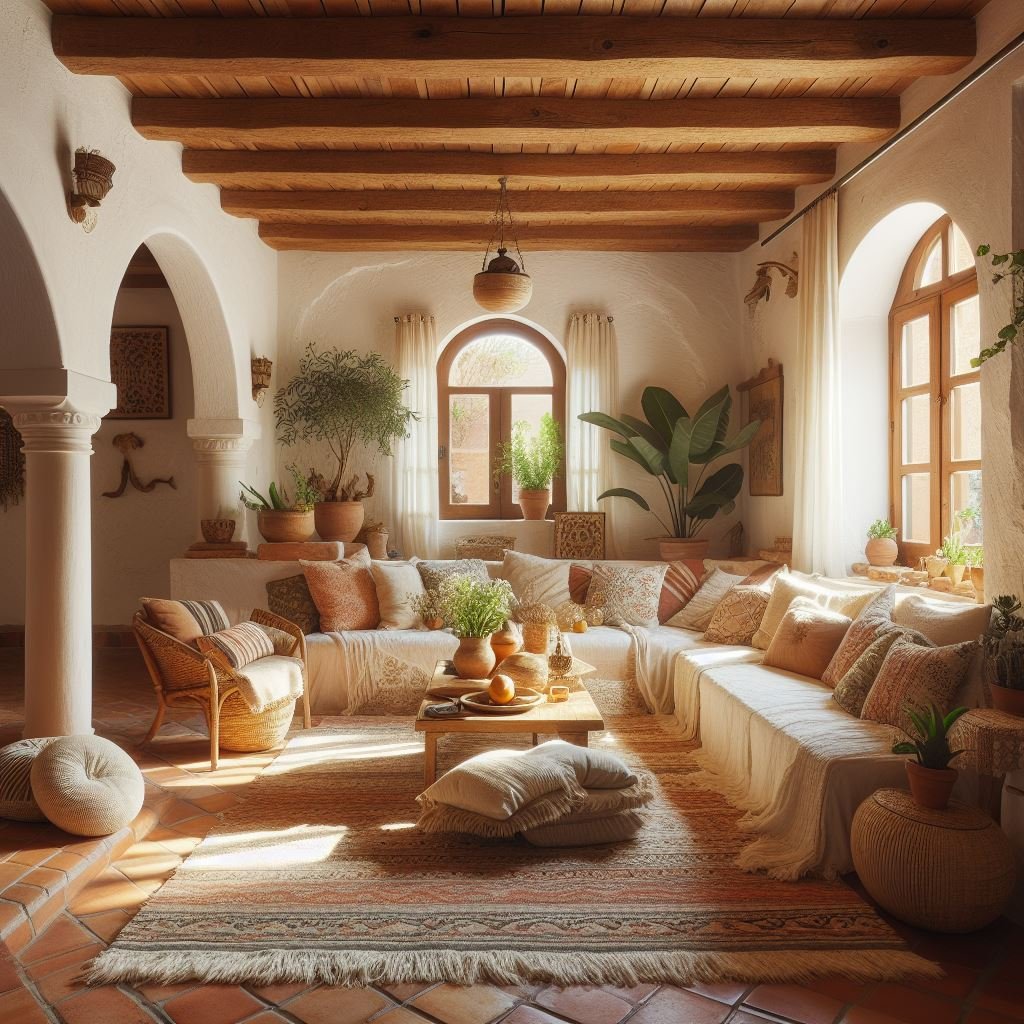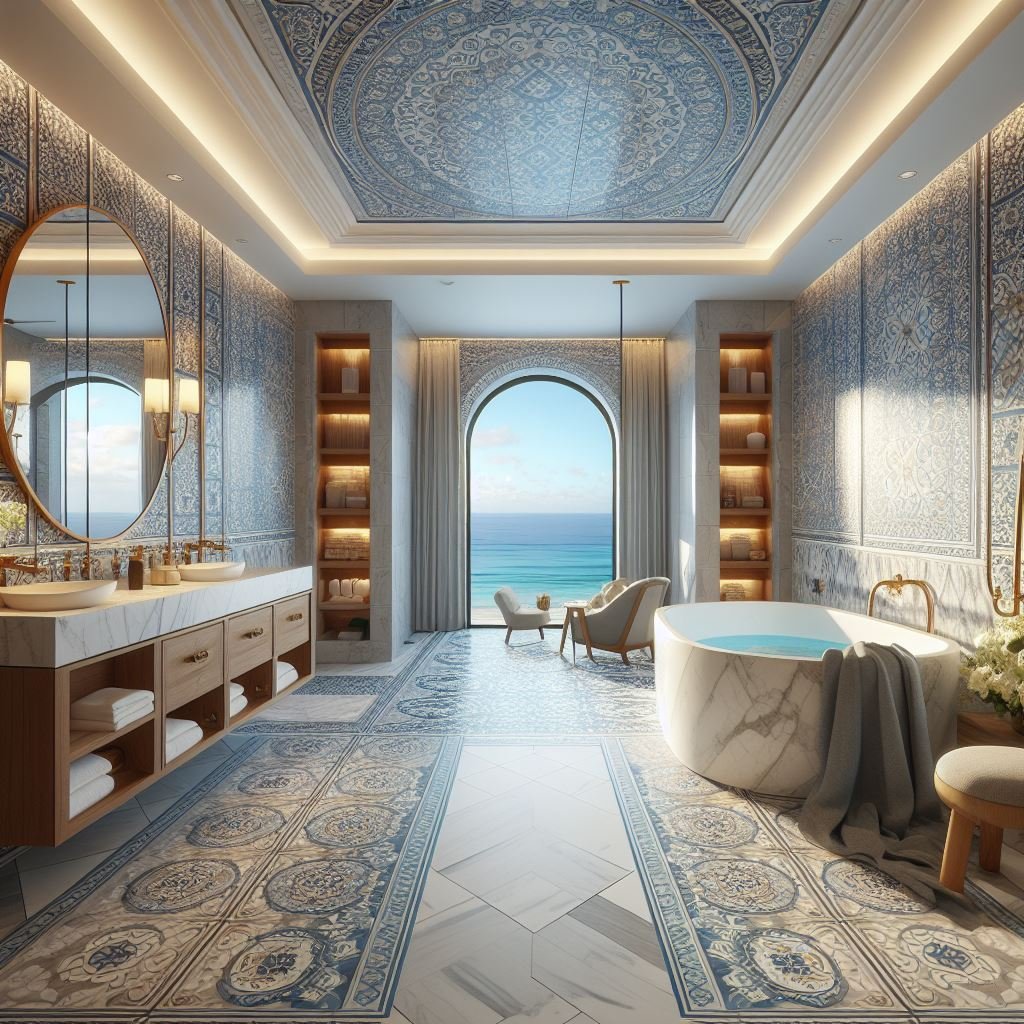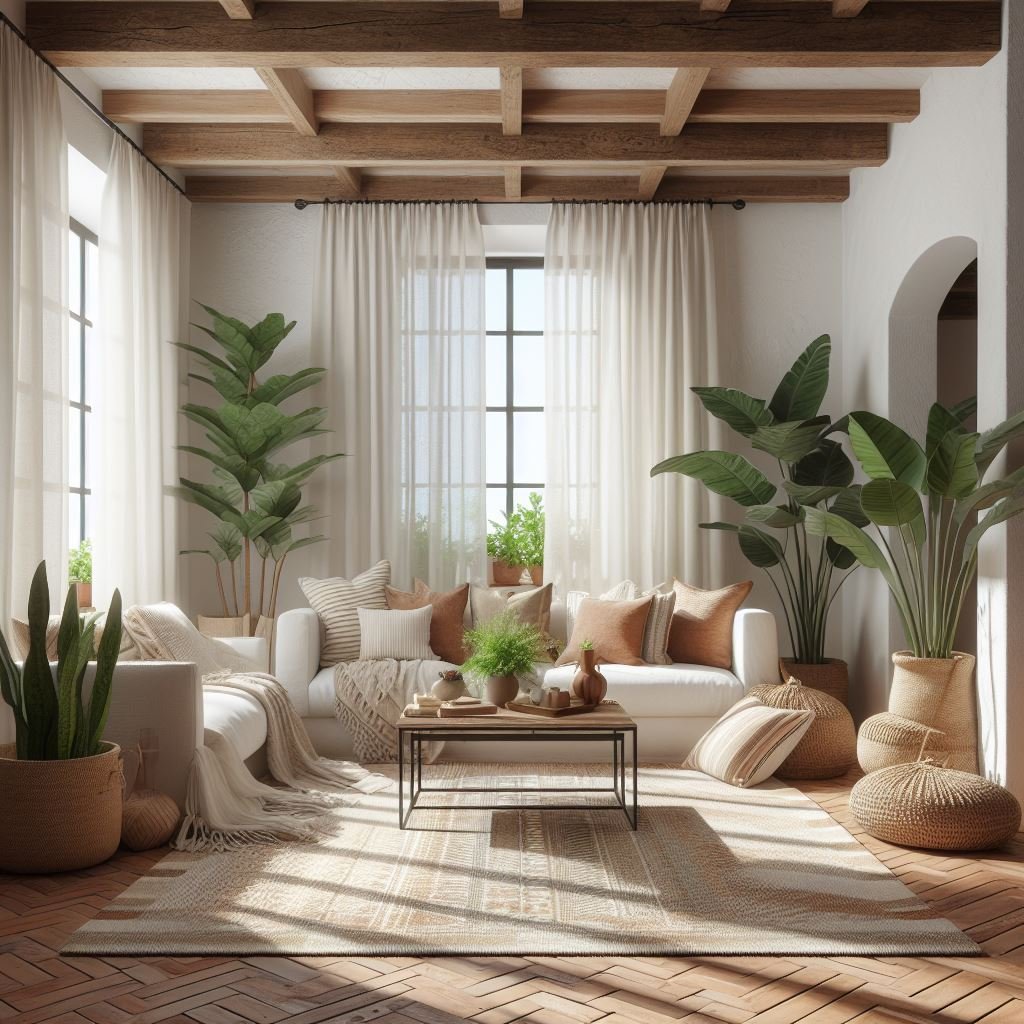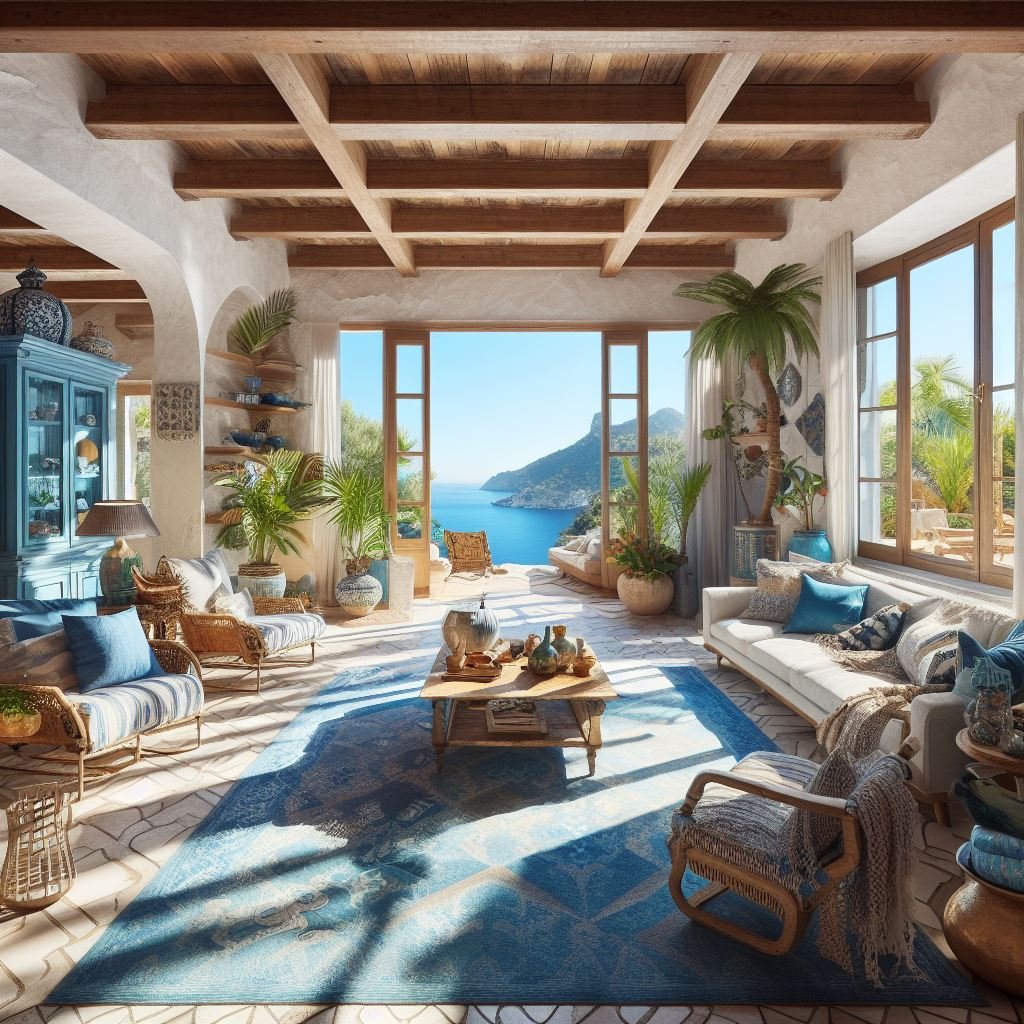How to Achieve Modern Mediterranean Interior Design
Transform your home with our guide on "How to Achieve Modern Mediterranean Interior Design." Discover tips, color schemes, and decor ideas for a fresh, sun-kissed look.
Imagine stepping into a room bathed in warm, earthy tones, with sunlight filtering through sheer curtains, and the gentle rustling of olive trees just outside. This isn’t just a vacation dream—it’s the essence of Modern Mediterranean interior design. Combining the best of traditional Mediterranean elements with contemporary flair, this style is all about creating a welcoming, airy, and effortlessly chic atmosphere. In this guide, we’ll explore How to Achieve Modern Mediterranean Interior Design, offering tips and inspiration to bring this sun-soaked style into your home. So, grab your sunhat and let’s dive in!
Understanding Modern Mediterranean Interior Design
What is Modern Mediterranean Interior Design?
Before we jump into the how-tos, let’s break down what makes this style so unique.
Blend of Old and New: Modern Mediterranean design seamlessly integrates the rustic charm of traditional Mediterranean decor with sleek, contemporary elements. This style is all about finding the perfect balance between timeless elegance and modern comforts. Traditional features like arched doorways and terracotta tiles are combined with modern furnishings and minimalist decor to create a unique and inviting space.
Earthy and Natural: The emphasis on natural materials is a cornerstone of Modern Mediterranean design. Wood, stone, ceramic, and wrought iron are commonly used to bring an earthy, organic feel to the space. These materials add texture and warmth, making the environment feel grounded and welcoming. From wooden beams and stone fireplaces to ceramic tiles and iron accents, these elements create a harmonious connection to nature.
Light and Airy: Modern Mediterranean spaces are designed to be light and airy, reflecting the sun-drenched landscapes of the Mediterranean coast. This is achieved through the use of open floor plans, large windows, and light color palettes. Whites, creams, and soft neutrals are often used to create a bright and spacious feel, while strategic pops of color can add vibrancy and interest. Ample natural light enhances the sense of openness and creates a serene, inviting atmosphere.
Key Elements of Modern Mediterranean Interior Design
To nail the Modern Mediterranean look, focus on these core elements:
Natural Materials: The hallmark of Modern Mediterranean design is the use of natural materials that evoke the rustic charm of traditional Mediterranean homes. Incorporate elements like exposed wooden beams, which add a warm and rustic touch to ceilings, and stone walls that provide a sense of strength and permanence. Terracotta tiles, whether used for flooring or as accents, introduce earthy tones and a timeless appeal. These materials not only add character but also connect the interior space with nature, fostering a grounded and organic atmosphere.
Warm, Earthy Colors: The color palette in Modern Mediterranean design draws inspiration from the natural landscape. Warm neutrals like beige, cream, and taupe provide a soft, inviting backdrop. Accents of deep blues reflect the Mediterranean Sea, while olive greens bring in the lushness of olive groves. Sun-kissed yellows add a hint of warmth and vibrancy, reminiscent of the Mediterranean sun. This palette creates a soothing and harmonious environment, perfect for relaxing and entertaining.
Textured Fabrics: Texture plays a crucial role in creating the cozy, layered look of Modern Mediterranean interiors. Use textiles like linen, cotton, and wool to add depth and warmth. Linen curtains, cotton throws, and wool rugs not only contribute to the aesthetic but also enhance the comfort and tactile experience of the space. These materials are breathable and perfect for creating a relaxed, yet refined atmosphere.
Handcrafted Decor: Handcrafted elements are a distinctive feature of this design style, adding a personal and artisanal touch. Consider incorporating hand-painted ceramics, which can serve as beautiful accent pieces on shelves or tables. Woven baskets bring texture and functionality, perfect for storage or as decorative elements. Intricate metalwork, whether in the form of lighting fixtures, furniture accents, or decorative items, adds an element of craftsmanship and elegance.
Indoor-Outdoor Flow: One of the key principles of Modern Mediterranean design is the seamless integration of indoor and outdoor spaces. Achieve this by using large windows and glass doors that open up to patios or gardens, blurring the boundaries between the indoors and the natural world. Incorporate plenty of plants, both inside and outside, to enhance this connection and bring a touch of greenery and freshness into the home. Outdoor spaces can be furnished with comfortable seating and dining areas, making them extensions of the living space and perfect for enjoying the pleasant Mediterranean climate.
How to Achieve Modern Mediterranean Interior Design
1. Start with a Neutral Base
The foundation of Modern Mediterranean design is a neutral color palette.
Design Elements for Modern Mediterranean Interiors
Walls: To achieve a Modern Mediterranean look, choose wall colors in soft whites, creams, or light beiges. These tones brighten the space and create an airy, inviting atmosphere, serving as a neutral canvas for vibrant accents. They also reflect natural light, enhancing the sense of spaciousness and warmth.
Floors: The choice of flooring is crucial for grounding the design and adding warmth. Natural stone floors like limestone or travertine offer durability and a timeless appeal, bringing nature indoors. Terracotta tiles add rich, earthy color and character, while hardwood floors in lighter stains or reclaimed finishes provide a warm, classic look that complements various furniture styles.
2. Introduce Warm and Earthy Tones
After establishing a neutral base, it’s time to layer in warm and earthy tones.
Accent Walls: Accent walls add depth and visual interest to Modern Mediterranean spaces. Choose rich colors like olive green or terracotta to evoke the natural Mediterranean landscape. An olive green wall provides a serene backdrop for artwork, while terracotta adds warmth and coziness. Whether using bold colors or textured finishes like Venetian plaster, an accent wall can become a stunning focal point in your room.
Furniture: When selecting furniture for a Modern Mediterranean interior, opt for pieces that exude warmth and comfort. Choose warm woods like walnut or oak for tables and cabinetry, and complement them with earth-toned upholstered furniture. Rich leather sofas and soft fabric armchairs add texture and luxury, creating a cozy, inviting space. This blend of natural materials and comfortable designs ensures your home is both functional and aesthetically pleasing.
3. Embrace Natural Materials
Incorporating natural materials is key to achieving the Modern Mediterranean look.
Wood Elements: Incorporating wood elements is key to creating a warm Modern Mediterranean interior. Use rich woods like oak or walnut for furniture such as dining tables and cabinets. Exposed wooden beams enhance rustic charm, while wooden shutters add a classic touch. These elements bring warmth and a natural, timeless quality, connecting the space to nature.
Stone and Tile: Stone and tile are essential to Modern Mediterranean design, adding an earthy, textured feel. Stone walls create a striking backdrop, while tiled backsplashes with intricate patterns enhance kitchen and bathroom areas. Marble countertops add luxury and smooth surfaces. These materials bring authenticity and elegance, enriching the room's ambiance.
Woven Textures: Woven textures add a natural, outdoor vibe to your Modern Mediterranean home. Use woven baskets for storage or decoration, rattan chairs for cozy seating areas, and sisal rugs to define spaces and add comfort. These elements bring the outdoors inside, enhancing the casual, laid-back feel of the decor.
4. Play with Patterns and Textures
Patterns and textures are essential for adding depth and interest to your design.
Textiles: Textiles add color, texture, and warmth to Modern Mediterranean interiors. Use patterned throw pillows, rugs, and curtains to introduce vibrant hues and intricate designs. Bold colors like cobalt blue, terracotta, and olive green contrast against neutral backgrounds. Traditional-patterned rugs define spaces and add comfort, while airy curtains allow natural light to enhance the room's brightness.
Ceramics and Pottery: Ceramics and pottery are key in Mediterranean decor, showcasing artisan traditions. Hand-painted ceramics like plates, bowls, and vases add vibrant color and intricate patterns, perfect for decorative accents on shelves or tables. Large clay jars or amphoras serve as statement pieces, adding earthy tones and rustic appeal. These items bring authenticity and craftsmanship to Modern Mediterranean interiors.
5. Focus on Lighting
Lighting plays a crucial role in creating the warm, inviting ambiance characteristic of Modern Mediterranean design.
Natural Light: Natural light is essential in Modern Mediterranean interiors, creating a bright, airy feel. Maximize sunlight with large windows and glass doors. Use sheer curtains to filter light and maintain privacy. This approach uplifts the mood and highlights the textures and colors in your decor, making the space feel vibrant and inviting.
Ambient Lighting: As the sun sets, create a cozy ambiance with warm ambient lighting. Wrought-iron chandeliers offer a rustic elegance, ideal for dining rooms or living areas. Lanterns add old-world charm, suitable for indoor and outdoor use. Pendant lights with warm-toned bulbs provide ample, relaxing light, making your space inviting for evening relaxation.
Accent Lighting: Accent lighting adds depth and drama to your Modern Mediterranean interior. Use spotlights or wall sconces to highlight architectural features like stone walls, arches, or beams. Illuminate artwork and decorative objects to draw attention to unique elements. Accent lighting enhances visual appeal and creates a dynamic, engaging environment.
6. Create an Indoor-Outdoor Flow
A seamless transition between indoor and outdoor spaces is a hallmark of Modern Mediterranean design.
Open Layouts:Modern Mediterranean design emphasizes a seamless flow between indoor and outdoor spaces with open floor plans. This layout allows natural light to travel freely, creating a sense of spaciousness and fluidity. It showcases Mediterranean elements like rustic wood beams, stone flooring, and arched doorways, enhancing the inviting atmosphere for family gatherings and entertaining guests.
Outdoor Spaces: Outdoor living is key in Mediterranean design. Furnish patios or gardens with cushioned seating, outdoor sofas, and dining tables for alfresco meals. Add an outdoor kitchen or fireplace for versatile entertaining. Incorporate greenery, like climbing vines and potted shrubs, and use natural materials like wood, stone, and wrought iron to enhance the Mediterranean vibe.
Plants: Bringing the outdoors in is a hallmark of Modern Mediterranean design. Incorporate potted plants, olive trees, and herbs like rosemary and basil to add tranquility and freshness. Use terracotta pots or rustic planters to enhance the natural aesthetic. This approach not only improves air quality but also creates a serene, inviting environment.
7. Add Personal Touches
Personal touches make the space uniquely yours.
Artwork: Choosing the right artwork can enhance the Mediterranean feel of your home. Opt for pieces depicting Mediterranean landscapes, such as coastal scenes and olive groves, or abstract art in warm, earthy tones like terracotta, ochre, and deep blue. Mix framed prints, paintings, and ceramic wall art to create an eclectic, engaging display, infusing your space with Mediterranean culture and charm.
Travel Souvenirs: Personalize your space with Mediterranean travel souvenirs. Display shells, pebbles, and driftwood in glass jars or bowls to bring the seaside into your home. Frame travel photos for a gallery wall or scattered displays. Showcase local crafts like handmade pottery, woven textiles, and traditional jewelry on shelves or tables, adding decor that tells your unique travel stories.
Family Heirlooms: Incorporate family heirlooms to add sentimental value to your Mediterranean decor. Display vintage ceramics, antique furniture, or family photographs that blend old-world charm with modern elements. Items like a vintage tapestry, an old clock, or ornate dishes add depth and character, making your space uniquely personal.
Tips for Achieving a Cohesive Look
Mix and Match
Balancing Old and New: Balancing antique pieces with modern furniture is key to Modern Mediterranean design. Pair an antique wooden table with sleek chairs or a vintage chandelier with a minimalist living room. This mix creates a timeless, contemporary aesthetic, adding warmth and character. The thoughtful blend ensures a curated, lived-in feel without being overly styled.
Color Coordination: In Modern Mediterranean design, start with a neutral base like whites or beiges, and add accents in deep blues, greens, terracotta, or ochre. Incorporate antique pieces, such as an aged wood chest or a vintage ceramic vase, to introduce warmth and texture. This careful color coordination creates a balanced and inviting space.
Keep It Light
Avoid Overcrowding: The essence of Modern Mediterranean design lies in its open, airy spaces that evoke a sense of tranquility and relaxation. To achieve this, it's important to avoid overcrowding your rooms with too much furniture or decor. Start by carefully selecting a few key pieces that serve both functional and aesthetic purposes. For example, a well-placed, comfortable sofa, a stylish coffee table, and a few thoughtfully chosen accent pieces can set the tone for a living room without overwhelming the space.
Quality Over Quantity
Choose High-Quality Standouts: In Modern Mediterranean design, the focus is on selecting a few high-quality, standout pieces rather than filling the space with numerous items. Opt for furniture and decor that are both aesthetically pleasing and durable. For instance, a beautifully crafted wooden dining table, a luxurious leather sofa, or an intricately designed wrought-iron chandelier can serve as focal points in your room.
Timeless Appeal: Quality pieces often have a timeless appeal that transcends trends. Investing in well-made items ensures that they will remain stylish and functional for years to come. Look for classic designs and superior craftsmanship that reflect the natural beauty and elegance of the Mediterranean style.
Sustainable Choices: High-quality pieces tend to be more sustainable in the long run, as they are less likely to need replacement. Choosing furniture made from sustainable materials like reclaimed wood, natural stone, or eco-friendly fabrics can contribute to a more environmentally conscious home.
Comfort and Functionality: In addition to their visual appeal, quality pieces should also offer comfort and functionality. Choose seating that is both stylish and comfortable, tables that are sturdy and practical, and storage solutions that are both beautiful and useful. The goal is to create a space that is not only visually stunning but also comfortable and livable.
Personalized Touch: Investing in quality pieces allows you to personalize your space with items that reflect your taste and personality. Whether it's a bespoke armchair, a handcrafted ceramic vase, or a unique piece of art, these standout items can add character and a sense of individuality to your home.
Fewer, Better Items: Embrace the principle of "fewer, better items" by focusing on a curated selection of high-quality pieces. This approach not only enhances the aesthetic appeal of your space but also fosters a sense of calm and order, essential elements of Modern Mediterranean design.
Conclusion
Creating a Modern Mediterranean interior is all about capturing the essence of sun-soaked, coastal living while blending it with contemporary comfort and style. By following this guide on How to Achieve Modern Mediterranean Interior Design, you can transform your home into a warm, inviting sanctuary that reflects the beauty and tranquility of the Mediterranean. From choosing the right colors and materials to adding personal touches and creating an indoor-outdoor flow, each step brings you closer to achieving this timeless and elegant look. So, embrace the Mediterranean way of life and enjoy the beauty of your new space!
Happy decorating!
Frequently Asked Questions
What are the key colors in Modern Mediterranean interior design?
The key colors include warm neutrals (like beige and cream), deep blues, olive greens, terracotta, and sun-kissed yellows. These colors reflect the natural beauty of the Mediterranean landscape.
Can I incorporate Modern Mediterranean design in a small space?
Absolutely! Focus on light colors, natural materials, and maximizing natural light to make the space feel larger and more open. Use mirrors and reflective surfaces to enhance the sense of space.
How do I choose the right furniture for a Modern Mediterranean style?
Look for furniture with clean lines, natural materials (like wood or rattan), and warm, earthy tones. Comfortable, inviting pieces are key to achieving the relaxed feel of the Mediterranean style.
What kind of artwork suits Modern Mediterranean interiors?
Mediterranean landscapes, abstract pieces in warm colors, or even hand-painted ceramics can be great additions. Choose artwork that complements your color scheme and adds a personal touch.
How can I create an indoor-outdoor flow in my home?
Use large windows, glass doors, and open floor plans to connect indoor and outdoor spaces. Furnish outdoor areas with comfortable seating and plenty of greenery to enhance the seamless flow.









